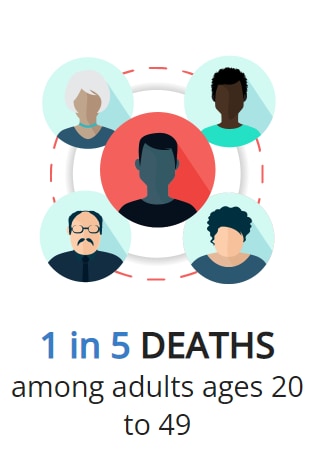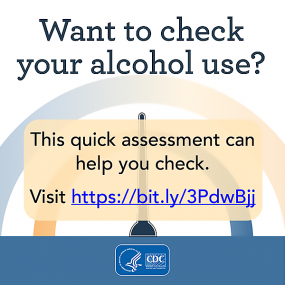About CDC’s Alcohol Program
- Excessive alcohol use contributes to more than 178,000 deaths in the US each year, shortening the lives of those who die by an average of 24 years.
- An estimated 1 in 5 deaths among US adults ages 20-49 is from excessive alcohol use.
- Alcohol-related emergency department visit rates were higher during the COVID-19 pandemic in 2020 than the two years prior.
- Excessive drinking cost the US $249 billion in 2010.
- Binge drinking is responsible for more than one third of the deaths and three quarters of the costs from excessive alcohol use.
- One in six US adults binge drinks, with 25% doing so at least weekly.
- People who binge drink are twice as likely to use other substances as people who don’t.
- Though underage drinking has declined in recent decades, in 2019, female high school students were more likely to drink alcohol and binge drink than males.
- States and communities can prevent binge drinking by supporting effective policies and programs, such as those recommended by the Community Preventive Services Task Force.
Our Mission
To prevent excessive alcohol use and its impact in states and communities through public health surveillance, partnerships, and applied research for translation into public health practice.
Our Goals
- Improve public health surveillance on excessive alcohol use, particularly binge and underage drinking, and related health outcomes.
- Increase the translation and communication of effective population-level strategies for preventing excessive alcohol use and related outcomes into public health practice.
- Expand state and local public health capacity in alcohol epidemiology and preventing excessive alcohol use.
- Provide national leadership on effective population-level strategies to prevent excessive alcohol use through collaborations and partnerships.
Established in 2001, the Alcohol Program is located in CDC’s Division of Population Health in the National Center for Chronic Disease Prevention and Health Promotion.
Our Work
Improving public health surveillance on excessive alcohol use, particularly binge drinking and underage drinking, and related health outcomes, including:
- Measuring the public health impact of excessive alcohol use among adults and youth, such as supporting the Alcohol-Related Disease Impact (ARDI) application, which provides state and national estimates of deaths and years of potential life lost due to excessive alcohol use.
- Using national surveys to conduct surveillance on drinking patterns and alcohol-related harms.
- Assessing the economic costs of excessive alcohol use.
Increasing the translation and communication of effective population-level strategies for preventing excessive alcohol use and related outcomes into public health practice, including:
- Developing and disseminating resources and tools on effective population-level prevention strategies.
- Supporting applied public health research and conducting surveillance of population-level policies to prevent excessive alcohol consumption.
- Implementing a mass communications campaign to reduce excessive drinking among U.S. adults.
Expanding state and local public health capacity in alcohol epidemiology and the prevention of excessive alcohol use, including:
- Funding state capacity in alcohol epidemiology.
- Providing technical assistance to state and local epidemiologists and other public health professionals to support effective prevention strategies.
Providing national leadership on effective population-level strategies to prevent excessive alcohol use through collaborations and partnerships, including:
- Supporting national public health activities to prevent excessive alcohol use, such as the Interagency Coordinating Committee on the Prevention of Underage Drinking.
- Collaborating with the Center for Advancing Alcohol Science to Practice, the Community Anti-Drug Coalitions of America, and other national partners to support the implementation of evidence-based recommendations on the prevention of excessive drinking in states and communities.

